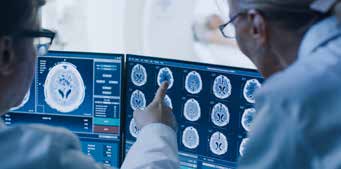Scientific
newsletters

The myelin sheath that surrounds and insulates nerve fibres is a membrane with a very particular composition, consisting of 70% lipids and 30% proteins. This proportion is the opposite of what is observed in the other membranes of the body’s cells. All membranes are very sensitive to oxidation phenomena which destroy them and any inflammatory reaction is accompanied by the release of oxidising products.
And the shadow plaques?
Is there spontaneous remyelination in the brain of patients suffering from MS? The answer is a resounding YES. Such spontaneous remyelination was suggested by the work of Olivier Périer and Anne Grégoire in 1965, two Belgian researchers who used electron microscopy for the first time to study MS lesions.
In 1970, John Prineas and his colleagues definitively confirmed that such remyelination was present. The new myelin sheaths are thinner than normal, but they again make it possible for nerve impulses to be transferred close to normal. These remyelinated plaques are called “shadow plaques”.
Several studies have since then shown that this remyelination can vary substantially from one person to another, as well as from one area of the brain to another in the same person. For example, a study of 51 autopsies showed extensive remyelination in 20% of patients, ranging from 60 to 96% of the total number of lesions. It has also been shown that remyelination was more frequent and more complete in recent plaques and in plaques located in the cerebral cortex. Conversely, very old plaques, located around the ventricles or in the cerebellum showed little or no sign of remyelination. We do not yet understand the causes of these differences between individuals and between different brain sites at this time.
What are the factors involved in blocking remyelination?
Unfortunately, there are many factors and they interact, making it difficult to find the best therapeutic target. They include:
- The persistence of low-grade inflammation in the periphery of old plaques, which are then called “chronic active”. These are activated macrophages that continue to destroy the myelin sheaths at the periphery of the lesion, causing a slow increase in their diameter. These macrophages often contain highly toxic iron atoms. They also contain a lot of fat and myelin fragments, which keeps them in a pro-inflammatory state. They release oxidising and neurotoxic substances. This inflammation cannot be visualised by an injection of gadolinium during an MRI scan.
- A cicatricial hypertrophy of astrocytes which replace the destroyed myelin and make the brain tissue hard and “sclerous”.
- A degeneration of nerve fibres that have lost their myelin sheaths, that may be deformed, and have a reduced capacity to produce energy molecules.
- An insufficient number of oligodendrocyte precursor cells (OPCs) and/or their incapacity to develop into mature oligodendrocytes capable of synthesising new myelin sheaths around nerve fibres.
How could we stimulate remyelination?
Needless to say, prevention is always better than cure and the first thing is to prevent the appearance of new plaques and therefore new areas of demyelination, thanks to our current anti-inflammatory drugs, which are increasingly more powerful: they make it possible to prevent the appearance of more than 90% of the active plaques that take up the contrast medium in MRI.
The most daunting challenge at the moment is to block the chronic inflammation around the older plaques
The most daunting challenge at the moment is to block the chronic inflammation around the older plaques, i.e. to block the activity of macrophages in the periphery of the lesions and more diffusely throughout the brain. There is also a population of lymphocytes that have diffusely invaded the brain tissue, whose inflammatory activity must be blocked. We therefore need drugs that can penetrate the blood-brain barrier in sufficient doses in the nervous system to achieve this goal.
Another challenge is to stimulate the OPCs to develop into mature oligodendrocytes and re-synthesise myelin sheaths.
Such stimulation may require the delivery of growth factors or differentiation factors through genetically modified regulatory lymphocytes, small nanomolecules or extracellular vesicles capable of crossing or short-circuiting the blood-brain barrier.
Such drugs with remyelinating potential should in any case be administered very quickly from the onset of the disease, concurrently with the anti-inflammatory drugs available to us in order to prevent the degeneration of nerve fibres and sclerosis by hypertrophic astrocytes.
In conclusion, remyelination of MS plaques is potentially feasible and is the subject of much research, as attested by the projects of many of the Foundation’s 2023 laureates.
Professor Emeritus Christian Sindic, President

Newsletter 53
Stay informed
Receive all the information related to research and news from the Belgian Charcot Foundation directly in your inbox.
